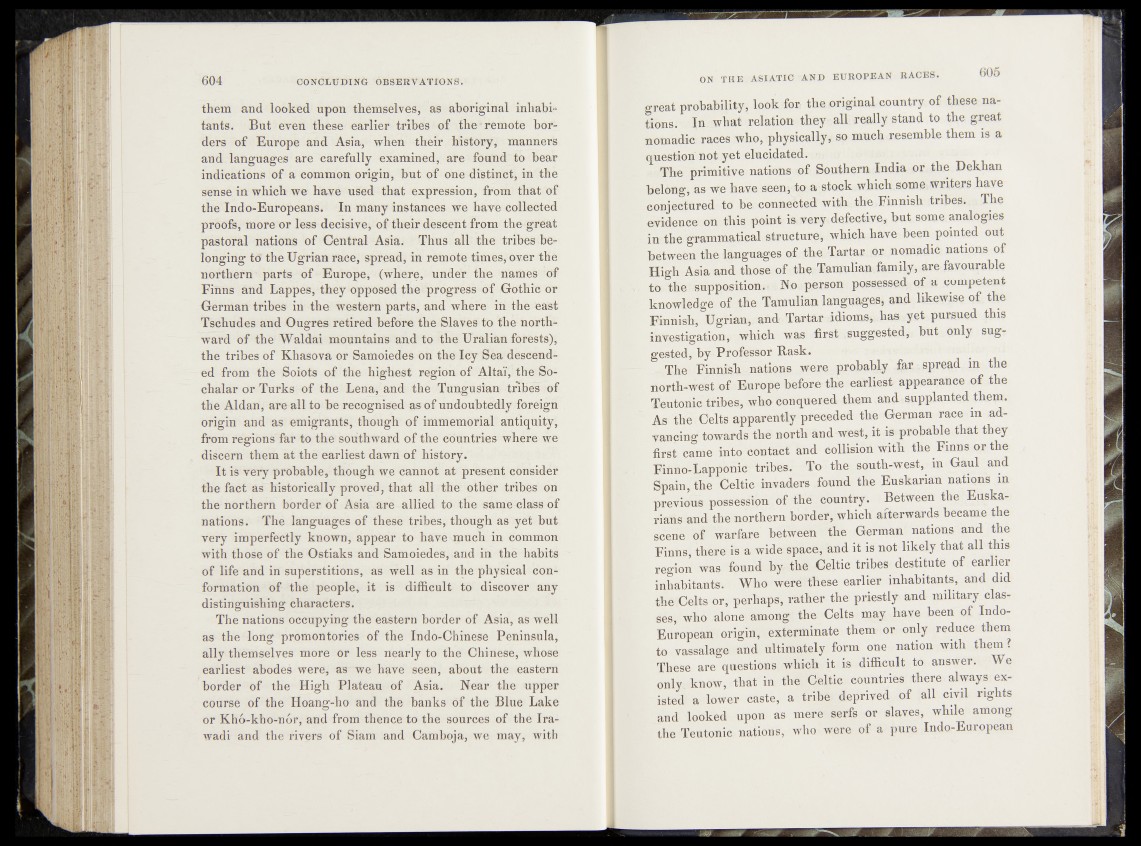
them and looked upon themselves, as aboriginal inhabi*
tants. But even thèse- earlier tribes I of the’remote borders
of Europe and Asia, when their history, manners
and languages are carefully examined, are found to bear
indications of a common origin, but of one distinct, in'the
sense in which we have used that expression, from that of
the Indo-Europeans. In many instances we have collected
proofs, more or less decisive, of their descent from the great
pastoral nations of Central Asia. Thus all the tribes belonging
td the Ugrian race, spread, in remote times,' over the
northern parts of -Europe, (where,! undet the names of
Finns and Lappes, they opposed the ^-progress of Gothic or
German tribes in the western parts, and where hi the Cast
Tschudes and Ougres retired before the Slave# to the noWfei
ward of the Waldai mountains and to the Uralian forestâ|f
the tribes of Khasova or Samoiedes oh the Icy Sèa descended
from the Soiots of the highest region of Altaï, the So-
chalar or Turks of the Lena, and- the Tungu sian Vtrlbds *of
the Aldan, are all to be recognised as of undoubtedly foreign
origin and as emigrants, though of immemorial antiquity,
from regions far to the southward of the countries Vffiére we
discern them at the earliest dawn of history.
It is very probable, though we cannot at present consider
the fact as historically proved, that all the other tribes on
the northern border of Asia are allied to the same class of
nations. The languages of these tribes, though as yet but
very imperfectly known, appear to have much dn common
with those of the Ostiaks and Samoiedes, and in the habits
of life and in superstitions, as well as in the physical conformation
of the people f it is difficult to discover any
distinguishing characters.
The nations occupying the eastern border of Asia, as well
as the long promontories of the Indo-Chinese Peninsula,
ally themselves more or less nearly to the Chinese, whose
earliest abodes were, as we have seen, about the eastern
border of the High Plateau of Asia. Near the upper
course of the Hoang-ho and the banks of the Blue Lake
or Kho-kho-nor, and from thence to the sources of the Ira-
wadi- and the rivers of Siam and Camboja, we may, with
great probability,; look for the original country of these nations.
In what relation they all really stand to the great
nomadic races who, physically^so much resemble them is a
question not yet elucidated. - (
; The primitive nations of Southern India or the Dekhan
foeleng, as we has» seenj to »-.stock which.some,writers have
conjectured to be* connected with;the Jinnish tribes*. The
©vidence-om.tMs point issverpdftfceivq* bu l some. analogies
in the grammatical structure, which„have been pointed out
between the languages of the Tartar or nomadic nations of
High Asia and those of the Tamulian. family, are favourable
to the supposition.. No, person possessed of a competent
knowledge of the Tamulian languages, and likewise qf. the
Finnish; Ugrian,, and-Tartar idioms, h a s,yet pursued this
investigation, which was first .suggested, hut only suggested,
by Professor Rask. - : - » ; - M M
The Finnish nations were pobabjy ^ .spread in the
north-west of Europe before the earliest appearance of the
Teutonic tribes, who conquered them ,and supplanted them.
As the ^ Celts apparently preceded the German race m advancing
towards the north and-west, it is probable that they
first came into contact and collision with the Finns or the
Finno-Lapponic tribes. To-the south-west, m Gaul and
Spain, the Celtic invaders found the Euskarian nations in
previous possession of the country. Between the Euska-
rians and the northern border, which afterwards became the
scene of warfare between the German nations and the
Finns, there is a wide space, and it is not likely that all this
region was found by the Celtic tribes destitute of earlier
inhabitants. Who were these earlier inhabitants, and did
the Celts or, perhaps, rather the priestly and military classes,
who alone among the Celts may have been of Indo-
European origin, exterminate them- or only reduce them
to vassalage and ultimately form one nation with them ?
These are questions which it is difficult to answer. We
only, know, that in the Celtic countries there always existed
a lower caste, a tribe deprived of all civil rights
and looked upon as mere serfs or slaves, while among
the Teutonic nations, who were of a pure Indo-European